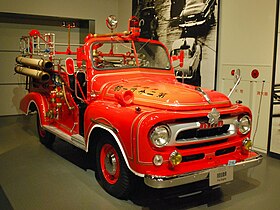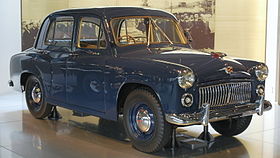Toyota RH
| Toyopet SA |
 |
| Overview |
| Manufacturer |
Toyota |
| Production |
Oct 1947–May 1952 |
| Assembly |
Honsha Plant, Toyota City, Aichi, Japan
|
| Designer |
Dr Kazuo Kumabe |
| Body and chassis |
| Class |
large family car |
| Body style |
sedan |
| Layout |
front-engine, rear-wheel drive |
| Platform |
backbone chassis |
| Related |
SB, SC
|
| Powertrain |
| Engine |
Type S |
| Transmission |
3-speed manual |
| Dimensions |
| Wheelbase |
2400 mm |
| Length |
3,800 mm (149.6 in) |
| Width |
1,590 mm (62.6 in) |
| Height |
1,530 mm (60.2 in) |
| Curb weight |
1,170 kg (2,579 lb) |
| Chronology |
| Predecessor |
AE |
| Successor |
SD |
| Toyopet SB |
| Overview |
| Manufacturer |
Toyota |
| Production |
1947–1952 |
| Assembly |
Japan |
| Body and chassis |
| Class |
light truck |
| Layout |
front-engine, rear-wheel drive |
| Platform |
ladder frame |
| Related |
SA, SC
|
| Powertrain |
| Engine |
995 cc Type S
|
| Transmission |
3-speed manual |
| Dimensions |
| Wheelbase |
2,400 mm (94.5 in) |
| Length |
3,950 mm (155.5 in) |
| Width |
1,595 mm (62.8 in) |
| Height |
1,800 mm (70.9 in) |
| Curb weight |
1,050 kg (2,315 lb) |
| Chronology |
| Successor |
SG |
| Toyopet SC |
| Overview |
| Manufacturer |
Toyota |
| Production |
3 prototypes in 1948 |
| Assembly |
Japan |
| Body and chassis |
| Class |
large family car |
| Body style |
sedan |
| Layout |
front-engine, rear-wheel drive |
| Platform |
ladder frame |
| Related |
SB |
| Powertrain |
| Engine |
Type S |
| Transmission |
3-speed manual |
| Chronology |
| Predecessor |
SA |
| Successor |
SD |
| Toyopet SD |
| Overview |
| Manufacturer |
Toyota |
| Production |
Nov 1949–1951 |
| Assembly |
Japan |
| Body and chassis |
| Class |
family car |
| Body style |
sedan |
| Layout |
front-engine, rear-wheel drive |
| Platform |
ladder frame |
| Related |
SB |
| Powertrain |
| Engine |
Type S |
| Transmission |
3-speed manual |
| Chronology |
| Predecessor |
SA |
| Successor |
SF |
| Toyopet SF |
| Overview |
| Manufacturer |
Toyota |
| Production |
Oct 1951–1953 |
| Assembly |
Japan |
| Body and chassis |
| Class |
large family car |
| Body style |
sedan |
| Layout |
front-engine, rear-wheel drive |
| Platform |
ladder frame |
| Related |
SG |
| Powertrain |
| Engine |
Type S |
| Transmission |
3-speed manual |
| Dimensions |
| Wheelbase |
2500 mm |
| Length |
4,280 mm (168.5 in) |
| Width |
1,590 mm (62.6 in) |
| Height |
1,600 mm (63.0 in) |
| Curb weight |
1,250 kg (2,756 lb) |
| Chronology |
| Predecessor |
SD |
| Successor |
RH |
| Toyopet SG |
 |
| Overview |
| Manufacturer |
Toyota |
| Production |
Mar 1952–1954 |
| Assembly |
Japan |
| Body and chassis |
| Class |
light truck |
| Layout |
front-engine, rear-wheel drive |
| Platform |
ladder frame |
| Powertrain |
| Engine |
Type S |
| Transmission |
3-speed manual |
| Dimensions |
| Wheelbase |
2500 mm |
| Length |
4,195 mm (165.2 in) |
| Width |
1,595 mm (62.8 in) |
| Height |
1,735 mm (68.3 in) |
| Curb weight |
1,170 kg (2,579 lb) |
| Chronology |
| Predecessor |
SB |
| Successor |
RK |
| Toyopet FHJ |
| Overview |
| Manufacturer |
Toyota |
| Assembly |
Japan |
| Body and chassis |
| Class |
light truck |
| Body style |
fire appliance |
| Layout |
front-engine, rear-wheel drive |
| Platform |
ladder frame |
| Related |
RH |
| Powertrain |
| Engine |
Type F |
| Dimensions |
| Length |
4,540 mm (178.7 in) |
| Width |
1,680 mm (66.1 in) |
| Height |
1,870 mm (73.6 in) |
| Curb weight |
965 kg (2,127 lb) |
| Chronology |
| Successor |
FH24 |
| Toyopet FHJ FH24 |
 |
| Overview |
| Manufacturer |
Toyota |
| Assembly |
Japan |
| Body and chassis |
| Class |
light truck |
| Body style |
fire appliance |
| Layout |
front-engine, rear-wheel drive |
| Platform |
ladder frame |
| Related |
RH |
| Powertrain |
| Engine |
Type F |
| Chronology |
| Predecessor |
FHJ |
The SA was Toyota's first new passenger car design (as opposed to updating the AA) after World War II. It was the first in a family of vehicles before the introduction of the Crown. A series of light trucks also shared the chassis and major components of these passenger cars.
All of these vehicles were sold under the Toyopet name.
The SA was Toyota's first true post war design. It differed from all previous Toyota cars by having a 4-cylinder engine (previously a 6-cylinder was used), 4-wheel independent suspension (previously using rigid axles with leaf springs) and a smaller, "ponton" influenced aerodynamic body. The project was driven by Kiichiro Toyoda under the wisdom of his father's (Sakichi Toyoda) words, "Stay ahead of the times" but most of the design work was done by Dr Kazuo Kumabe.
The body was aerodynamic in a style similar to the Volkswagen Beetle. Only a two-door sedan was made, making it unsuitable for the taxi market. The doors were hinged at the rear (often called suicide doors). The front window was a single pane of flat glass with a single wiper mounted above the driver. Only right hand drive was offered.
Toyota engineers (including Dr Kumabe) had visited Germany before World War II and had studied the 16-cylinder Auto Union racing car (independent suspension) and Porsche and Volkswagen designs (independent suspension, aerodynamic bodies, backbone chassis, rear-mounted air-cooled engines, economical production cost). Many Japanese companies had ties with Germany during the war years but most partnered with British or American companies after the war and thus used technologies commonly used in Britain or America. But Toyota did not partner with a foreign company, so it was free to use German designs. Many features of the prototype Beetle were subsequently put into the SA, although the Beetle's rear-mounted air-cooled engine feature was not used. Later on, Toyota revisited the economic principles exemplified by the Beetle when designing the Publica and the Corolla.
...
Wikipedia




